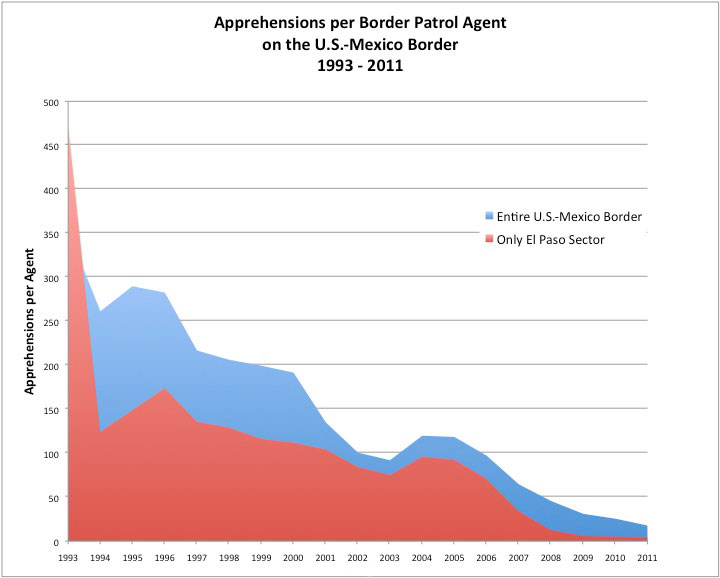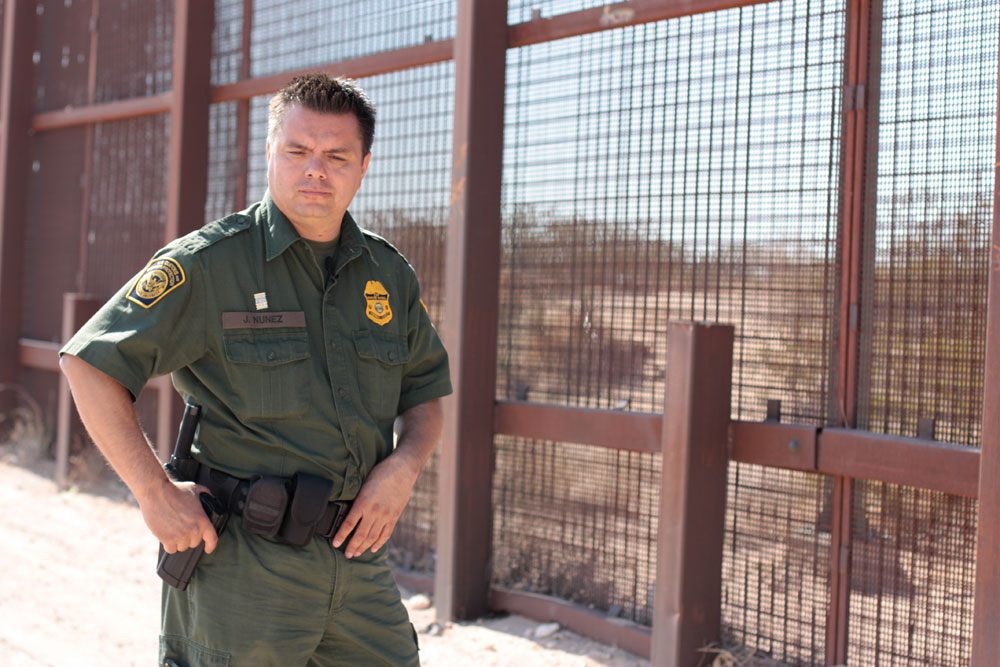EL PASO – Border Patrol agents might soon switch from sitting in trucks along the U.S.-Mexico border to helping traffic move more efficiently on the international bridges.
This scenario comes from the idea of Border Patrol agents collaborating with other government agencies and institutions.
Border Patrol Chief Michael Fisher in May announced a strategy plan to fight transnational crimes and drugs, support Homeland Security efforts and aid U.S. Customs and Border Protection.

A sign marks an area restricted by the U.S. Border Patrol near the line between Juarez and El Paso. (Mariana Dell/Borderzine.com)
One possible outcome might be reassigning Border Patrol agents to Customs border crossings to reduce the long wait.
“Currently Customs and Border Protection needs all of the staffing help that they can get – in particular at our ports of entry,” said El Paso City Representative, Steve Ortega, through an email statement.
As Border Patrol agents apprehend fewer undocumented people each year, its mission as an agency with resources focused on deterring and apprehending undocumented crossers is being reconsidered.
Currently, Immigration and Customs Enforcement (ICE) personnel in the El Paso area of responsibility are apprehending and removing more undocumented people through the Secure Communities Program, employment raids and by catching crossers at major ports of entry than the Border Patrol, according to Border Patrol and ICE enforcement and removal figures.
That is why the Border Patrol 2012-2016 Strategic Plan calls for redirecting its agents’ efforts toward relieving congestion and waits at the ports of entry, as well as combating terrorism and transnational crime.

In light of a dramatic decrease in apprehensions of undocumented crossers, a recently issued Border Patrol 2012-2016 Strategic Plan calls for redirecting its agents’ efforts toward relieving congestion and waits at the ports of entry, as well as combating terrorism and transnational crime. By the close of FY 2011, the typical Border Patrol agent working from Texas to California was apprehending 17.7 undocumented people a year, from a high of 352.2 per agent in 1993. In comparison, the numbers fell even more for agents in the El Paso Sector, from a high of 470 apprehensions per agent in 1993 to only 3.8 apprehensions by 2011.(Richard Schaefer/Borderzine.com)
By the close of fiscal year 2011, the typical Border Patrol agent working from Texas to California was apprehending 17.7 undocumented people a year, from a high of 352.2 “illegal alien apprehensions” per agent in 1993. In comparison, the numbers fell even more for agents in the El Paso Sector, from a high of 470 apprehensions per agent in 1993 to only 3.8 apprehensions by 2011.
More agents at entry checkpoints would be a relief for some people of El Paso.
“People would cross to go to work, or to go to restaurants and enjoy the nightlife. They would cross to see family and they would cross to engage in trade. It used to be pretty easy to cross and it’s gotten more and more difficult,” said border journalist Louie Gilot.
Gilot is the publisher of Newspaper Tree, a non-profit online news organization in El Paso. Previously, she covered immigration issues as a reporter for the El Paso Times.
For those who cross the border back and forth as part of their daily lives, long waits are too time consuming.
“There used to be no lines when you were going on foot and now there is. I have spent an hour on foot,” Gilot said.
Gilot also mentioned that a friend recently spent three hours on the international bridge in her car waiting to come back into the United States.
Other residents of El Paso think if U.S. Customs and Border Protection needs more help to move traffic faster at busy border crossing points, it should come up with another solution.
“I think Border Patrol should be left alone to do their jobs on the side and let the Customs hire more people,” said David Faulkner, recreation specialist at El Paso Chihuahuita Recreation Center.
Changes in numbers and technology

Border Patrol Agent, Jacob Nuñez, walks along a standard pedestrian fence in New Mexico. The fence is an example of a collaboration between the Border Patrol and local landowners. (Mariana Dell/Borderzine.com)
With the implementation of Operation Hold the Line in El Paso in 1993, the Border Patrol strategically deployed resources to meet the highest priority threats.
There has been a 53 percent decrease in apprehensions of undocumented border crossers since 2008, according to Fisher’s testimony at a hearing of the Homeland Subcommittee in Washington.
One of the aspects of the new strategy plan is for the Border Patrol to improve the use of new equipment to keep those numbers down.
“Technology is a very big part of what we do here,” said Jacob Nuñez, Border Patrol agent. Once Border Patrol agents just used flashlights, they now have powerful binoculars with night vision, remote video surveillance systems and even truck roof cameras that work on hydraulics to rise up and scan the area.
Agents in the neighborhood
In Chihuahuita, one of the El Paso neighborhoods a stone’s throw away from Ciudad Juarez, violence and safety is not a concern for some residents since an 18-foot wall was built between the U.S. and Juarez in 1993. Border patrol agents no longer are commonly seen chasing illegal crossers through the streets.
“We go to sleep at ease here thanking God when we go to sleep and back again when we wake up… I am very happy living here,” said Concepcion Concha Flores, a resident of Chihuahuita for 10 years.
Border Patrol agents host community events with the residents of Chihuahuita. An example is the annual Christmas party at the El Paso Chihuahuita Recreation Center in the heart of the neighborhood.
“The border patrol workers give the donation and presents and all that, and we have someone who does Santa Claus and we have food for them that day also,” Faulkner said.
Fisher expects the Border Patrol strategy plan to be completed in 2013.
_____
Related information: United States Border Patrol Statistics



Hey, may as well reassign BP to packing lunches for the illegals that come through even though Homeland Security says our borders are more secure now than ever. Why not just put signs up (In Spanish, of course) saying, “Welcome, amigos, to Los Estados Unidos. We are prepared to give you immediate citizenship, pay for your medical needs, educated your children from k-through college, give jobs to all your family and then send for all the relatives you left behind. We will also help with anything you need. Just line up at the welfare office and tell us what you want. We promise to learn Spanish so you won’t have to bother with learning English. Our politicians especially want to welcome you . They know that if they pander and slobber all over “Latinos” that you will vote for anyone who promises giveaways and will, in turn, get donations and votes from the traitors who hire you. So, come on in. We’re done anyway.
El Paso/Juarez is one community divided by an artificial political and physical barrier. The long waits on the international bridges hurt legitimate two-way commerce and separates extended families with members who live and work on both sides. Anything both governments can do (including deploying BP to help with Custom’s work) to ease the border crossing process strengthens border communities.
This story uses statistics in a disengenous manner. The border patrol had an estimated 4500 agents in 1993. It now has over 20,000, a more than four-fold increase. The article fails to mention this change and sacrifices integrity to attempt to make a more dramatic comparison between apprehensions per agent in 1993 and 2011.
Why not report the facts and allow us to interpret?
Klab, you are right in a way. But, the numbers also show, that today, the agents are less busy then before. Stats are stats, and anyone can use them to prover their point, but overall, there seems to be less activity between the ports of entry for now, then ever before.
What a crock of BS! There are aliens pouring over the border, regardless of what Aguilar, Napolitano, and Fisher try to spin. There are smuggling loads of people that are intercepted daily…within the INTERIOR of the United States…where the hell they coming from? 5 were found burned to death in an SUV yesterday…where did they come from? You want the TRUTH about the border, get the M3 Report (free) which is produced by Border Patrol Agents who want the truth to be known, not the lies of political hacks.
And as far as the low apprehension numbers…when you don’t seek, you don’t catch, hence apprehension numbers are artificially lowered.
The wait lines in El Paso are the crossers problems. People crossing every single day, the same people over and over they add little to the economy. Most are simply being disingenuous about why they are coming over and coming to actually work.
Between those illegally working here, and the ones who cross the bridge 8 months and 25 days pregnant so they can drop yet another anchor baby… (which is very little reported, how many US citizen children are living in Juarez) they don’t pay for the childs birth, they collect welfare on the child while still living in Juarez, they send the child to schools in the US while living in Juarez, pay no taxes and on and on….I say screw em let them wait. They’re not that important. Well unless you happen to be part of the Walton family…then they’re spending all their hard earned paso’s at Walmart.
Annex them and make them part of the U.S. They become U.S. citizens without leaving their country, they get to pay U.S. taxes, they receive the same benefits as U.S. citizens (our laws, like minimum wage & other labor laws) education, health (let them experience obamacare too!), social services, etc. Now, they have no reason to leave home, and this solves our border problem (this much of it atleast).
Some of the comments to this article are opinions based personal ideologies. The same anti-immigrant, anti-Hispanic mantra is repeated over and over again, because we all know that a lie told often enough becomes the truth… The El Paso-Juarez region is a region artificially divided, as it is the case with other towns along the US – México border. Why no one talks about businesses in El Paso that depend almost entirely in the business they get from Juarenses? One of the things that I love about websites like Borderzine is that they are open for anybody to post comments. A whole different story is that the content of many of this comments are plainly misinformed and in many occasions, hateful and incendiary.